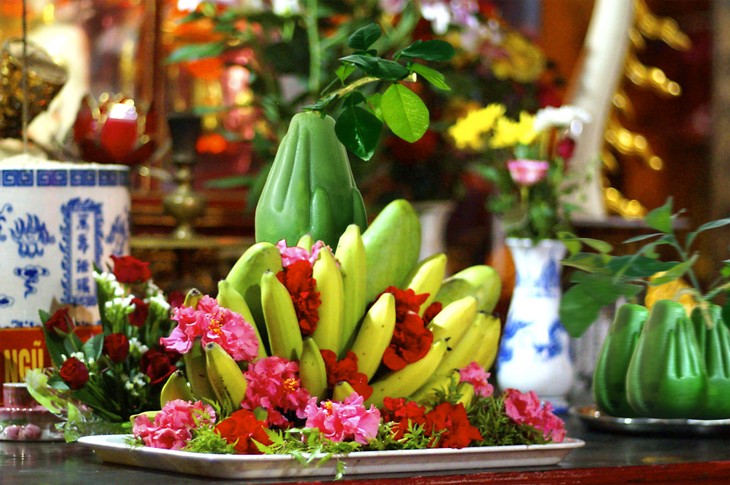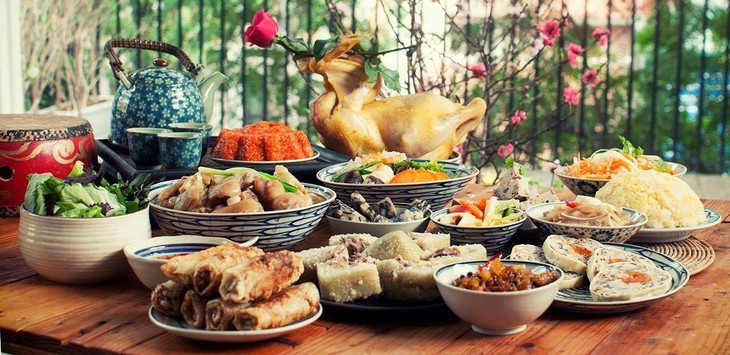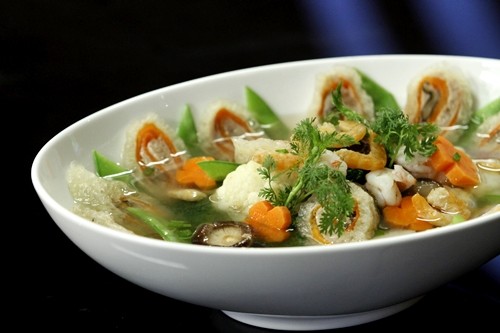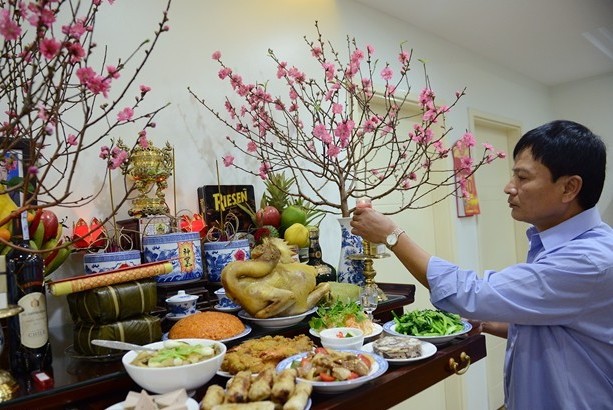(VOVworld) - The last day of the lunar year is very important to Vietnamese people. The feast eaten in the evening of this sacred day tends to be more abundant and elaborate than usual, as it will be offered to ancestors at the family altar. Today VOV explores this beautiful and meaningful custom of the Vietnamese people.
Vietnamese people start preparing for the last meal of the Lunar year from the early morning. Women would go to markets to buy the finest ingredients for the meal while men would be cleaning the altar and preparing the offerings to their ancestors including a five-fruit tray. Southerners prefer sugar-apples, coconuts, papayas, mangos and Fig fruits for this five-fruit tray as they sound like “wishing for enough fortune” in Vietnamese, while people in the North have a totally different way of choosing fruits. Nguyen Vu Thanh Quy in Hanoi, said:
“In my family, we usually start preparing everything since the morning. Dad would help with cleaning the house while mom and I would go to the market ealy to buy the most beautiful flowers, usually gladiolus or chrysanthemum, and 5 types of fruits to be placed on the altar. They must include a green banana split because it symbolizes the bond between family members, who will always gather around and protect each other, a pomelo to express our yearn for peace and prosperity. The rest may vary from family to family. We normally have a Buddha's hand fruit to seek for Buddha’s protection or oranges to symbolize success. There are must-have items that every family would have.”
 |
The meal offerings to the ancestors must include a five-fruit tray. (Photo: tinmoi.vn)
|
Fruits to offer to ancestors can differ in different parts of Vietnam, depending on their respective weather conditions at the time and on available local agricultural products. However, the common thing is each tray must have 5 fruits as people consider it a lucky sign. Pham Thi Tuyet, a 62-year-old culinary artisan in the Old Quarter of Hanoi who is famous for preserving the authentic Hanoi’s dishes, said:
“Families must have a five-fruit tray on the altar. The elderly often decorate the altar with a branch of Camellia or Peach blossom. Those are the 2 must-have elements for the Lunar New Year Eve. To Vietnamese people, the number 5 means multiplying, prosperity flourishing and a bumper crop. The fruit tray of 5 different types of fruits is for that reason. The fruit tray must have a green banana bunch, a pomelo, a buddha's hand fruit, oranges and Vietnamese kumquat. But in the old days, the variety of agricultural products is much restrictive compared to nowadays.”
Aside from flowers and a five-fruit tray, on the last day of the year, families would also prepare a plentiful feast to be placed on the altar, which must include the two important dishes of Chung cake (Vietnamese square sticky rice cake) and a boiled whole-chicken. Ha Ngoc Khanh, a Hanoi citizen, said:
“Chung Cake is a must because it shows the harmony of the heaven and earth and expresses people’s hope for a prosperous year. The chicken symbolizes our gratitude to ancestors; every household will have this dish. Sometimes the seniors can observe the posture of the chicken to see if the family can have a smooth year. They even believe the shape of its leg can forecast whether a flourishing business will come to them in the new year.”
 |
| Each element in the sacred last meal of the year has a meaning to Vietnamese people. (Photo: timeoutvietnam) |
However the preparation of Chung cakes must be done days ahead of the 30th night as it needs time and lots of effort to make. Khanh again:
“When I was younger, families usually started preparing to cook Chung cake since the 25th or the 26th. They went out to buy dong leaves and pork, while flaying beans and soaking rice at home. Children would gather around to watch the elderly wrap the cakes slow-cook them in the fire stove later at night. I remembered my grandfather appreciate each leaf and would hand-clean it carefully. He also made us some small-sized cakes to eat in the following morning. It was really fun! Now families don’t do that anymore, even in my house.”
Though it is really common to see a variety of soups, fried, boiled, or stewed dishes, meat, fish, vegetable, the citizens of Hanoi have come up with a special dish that cannot be mistaken to any other places. Thanh Quy said:
“The soup cooked with pork skin to offer to ancestors is a unique tradition to only people of Hanoi origins. It is very difficult and sophisticated to make. The soup includes dried pork skin, shrimp, lean pork, several seasonal vegetables including broccolis and carrots and cooked meat stock. Not to mention that making the stock was really complicated. It includes the stock from chicken and shrimp and thus has both the sweet and light flavours. The soup looks really colorful, delicious and luxurious.”
 |
The unique soup cooked with pork skin for Tet looks really colorful, delicious and luxurious. (Photo: Zing)
|
The fine combination of sweet and savory, of graciousness and luxury represents the richness and harmony in life of living people and their sincerity to gods and ancestors, seeking for the spiritual protection and support from the Holies. Yet the citizens of Hanoi have added to the feast a touch of delicacy and high expectations as a result from a millennium of cultural accumulation. Tuyet again:
“In the old days, the meal for Tet prepared by Hanoi citizens was very sophisticated. They didn't eat in big dishes like Westerners but in many, many small dishes. Those who prepared had to do a lot of hard work, including preparing an enormous amount of food ingredients and materials for the meal. The people of Hanoi ate lightly and elegantly because they considered eating in big sizes was an act of rudeness and vulgarity. They eat for joy and thus they had specific requirements for each dish. Now people just place food in big dishes, which would make you full after one or two. People in the past might need to spend 1 whole day for the complicated preparation”.
 |
Right before the New Year Eve, the meal will be officially offered to ancestors on the altar, as the oldest man of the family will burn the incense and say the prayers. (Photo: Bao Giao Thong)
|
Right before the New Year Eve, the meal will be officially offered to ancestors on the altar, as the oldest man of the family will burn the incense and say the prayers. Quy said:
“We will offer a meal along side with a fruit-tray, flowers, candles, votive paper, tea and alcohol, salt, rice and other sweets. My family also places two sugarcanes next to the altar to symbolize the stairs for ancestor to “come down” to the world. My dad then will thank the Buddha, other Gods and Spirits and my ancestors for their help during the old year and our hope for their continued support to give us a smooth year with health, security and prosperity and invite them to spend Tet with us in the next 3 days. After the incense burns out, we will enjoy the meal full of “fortune”our ancestors have blessed.”
The last meal of the Lunar New Year is the time for family reunions. Together with other national holidays and festivals, Tet traditions are vivid reflection of Vietnam’s culture.